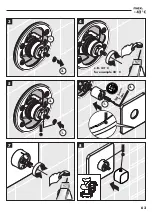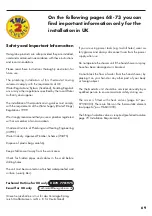
73
In-servicetests
Purpose
The purpose of in-service tests is to regularly monitor and
record the performance of the thermostatic mixing valve.
Deterioration in performance can indicate the need for
service work on the valve and/ or the water supplies.
Procedure
1.
Carry out the procedure
2.
(a) to (e) on page 71
using the same measuring equipment, or equipment
to the same specifications.
2.
If the mixed water temperature has changed signi-
ficantly from the previous test results (e.g. > 1 K),
record the change and before re-adjusting the mixed
water temperature check:
a) that any in-line or integral strainers are clean
b) any in-line or integral check valves or other
anti-backsiphonage devices are in good working
order
c) any isolating valves are fully open
3.
With an acceptable mixed water temperature, com-
plete the procedure
2.
(a) to (e) on page 71.
4.
If at step
2.
(e) on page 71 the final mixed water tem-
perature is greater than the values in Table A and / or
the maximum temperature exceeds the corresponding
value from the previous test results by more than about
2 K, the need for service work is indicated.
NOTE: In-service tests should be carried out with a
frequency which identifies a need for service work
before an unsafe water temperature can result. In
the absence of any other instruction or guidance, the
procedure described in „Frequency of in-service tests“
may be used.
Frequency of in-service tests
TMV3*
General
In the absence of any other instruction or guidance on
the means of determining the appropriate frequency of
in-service testing, the following procedure may be used:
1.
6 to 8 weeks after commissioning carry out the tests
given in
2.
on page 71.
2.
12 to 15 weeks after commissioning carry out the tests
given in
2.
on page 71.
3.
Depending on the results of
1.
and
4.
several possi-
bilities exist:
a) If no significant changes (e.g. <
1 K) in mixed
water temperatures are recorded between com-
missioning and
1.
, or between commissioning and
4.
the next in-service test can be deferred to 24
to 28 weeks after commissioning.
b) If small changes (e.g. 1 to 2 K) in mixed water
temperatures are recorded in only one of these pe-
riods, necessitating adjustment of the mixed water
temperature, then the next in-service test can be
deferred to 24 to 28 weeks after commissioning.
c) If small changes (e.g. 1 to 2 K) in mixed water
temperatures are recorded in both of these peri-
ods, necessitating adjustment of the mixed water
temperature, then the next in-service test should be
carried out at 18 to 21 weeks after commissioning.
d) If significant changes (e.g. > 2 K) in mixed water
temperatures are recorded in either of these
periods, necessitating service work, then the next
in-service test should be carried out at 18 to 21
weeks after commissioning.
4.
The general principle to be observed after the first 2 or
3 in-service tests is that the intervals of future tests should
be set to those which previous tests have shown can be
achieved with no more than a small change in mixed
water temperature.
*TMV2: The frequency of performing the in-
servicetestsis1yearmaximum.
Summary of Contents for Axor Urquiola
Page 25: ...68 0 3 MPa 67 68 MTC 42 C 65 C 180 180 60 25...
Page 27: ...68 0 3 67 68 42 65 180 60 27...
Page 43: ...68 0 3 MPa 67 68 42 C 65 C 180 180 60 43...
Page 55: ...68 0 3 67 68 42 C 65 C 180 180 60 55...
Page 58: ...68 0 3 67 68 42 65 180 180 60 58...
Page 59: ...1 0 5 0 1 1 6 PSI 147 10 1 80 C 65 C 4 70 C 64 DIN EN 1717 DIN 1988 62 62 42 66 68 59...
Page 60: ...60 1 2 mm X Montage 2 1 2 2 SW 4 mm 5 Nm 3 4 5 1 01800180 1 2 3...
Page 61: ...61 Montage 3 4 S W 3 m m 2 N m 2 1 7 6 8 9 10 11 X 11 0 1 Nm...
Page 62: ...62 Safety Function Justierung 2 1 3 1 1 2 S W 3 m m 2...
Page 63: ...63 z B 42 C for example 42 C 2 1 1 2 3 4 5 6 7 8 S W 3 m m 2 N m 1 2...
Page 64: ...64 Wartung 1 2 3 2 3 4 5 6 SW 24 mm SW 4 mm 1...
Page 65: ...65 Wartung 2 1 8 9 10 11 12 SW 24 mm 15 Nm SW 4 mm 5 Nm 7...
Page 75: ...75...




































